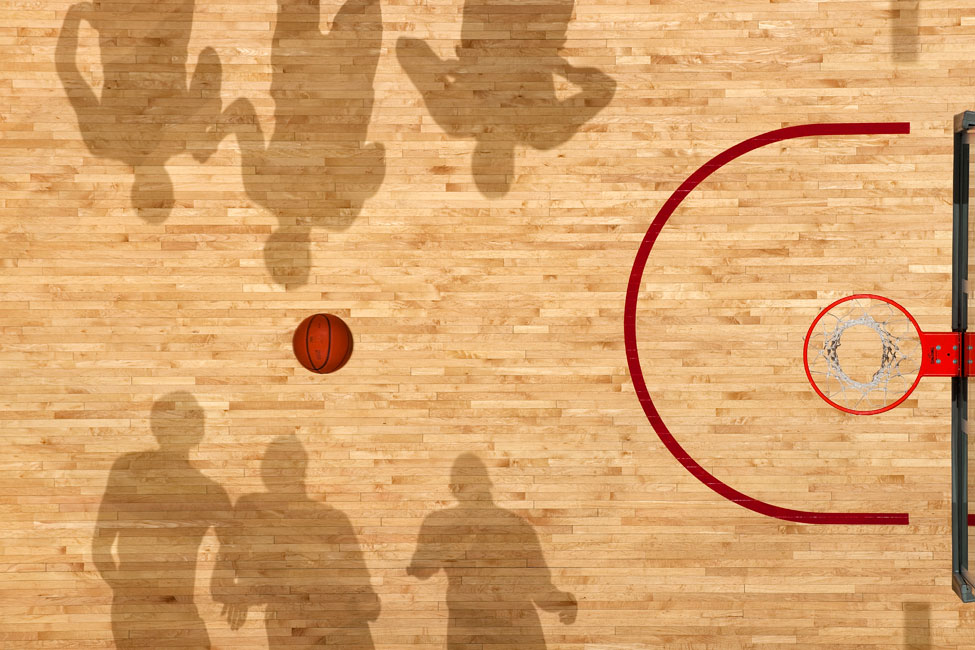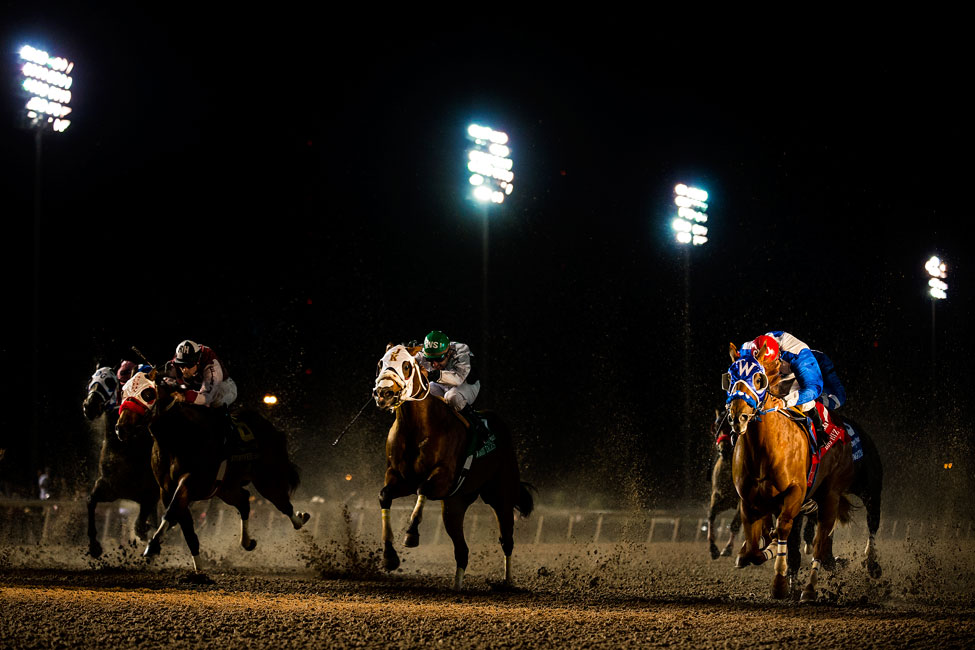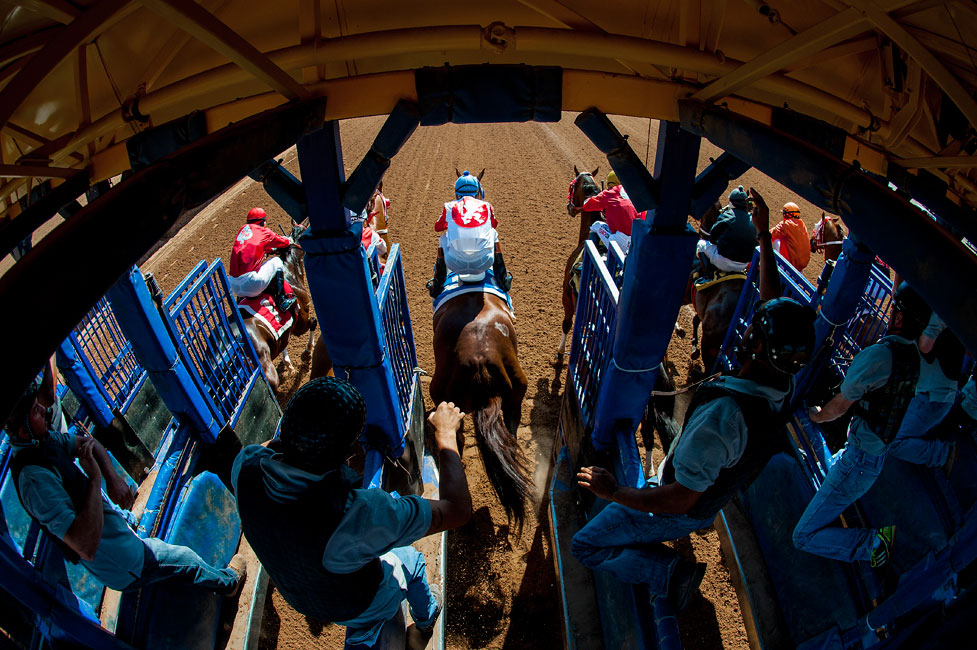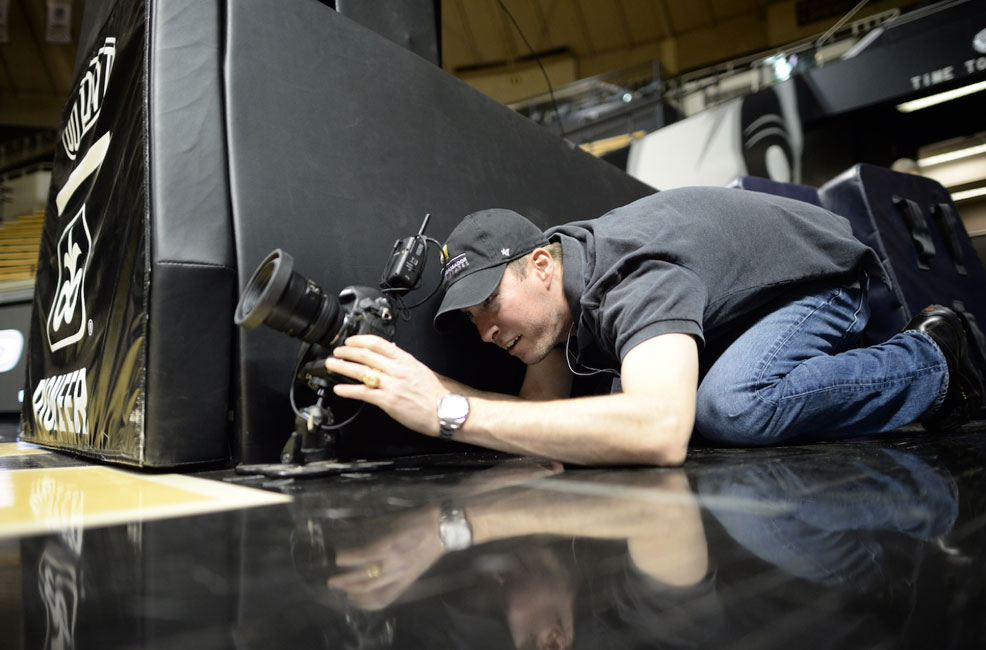Shooting with Remote Cameras
D3X, AF-S NIKKOR 70-200mm f/2.8G ED VR II, 1/250 second, f/8, ISO 125.
I had the camera mounted in the catwalk above the hoop. I positioned the strobes in the arena perpendicular to the area between the basket and the free throw line to cast shadows into the lane. I would then shoot as the ball was on its way to the basket to get an image of the ball in flight and shadows of the players on the floor. This was part of an 8-camera setup that is standard for most basketball games I cover.
Photography is a powerful tool of expression and communication. For me, it is the most powerful of tools. I’m always looking for new, different, more dramatic ways to tell a story. When it comes to sports, the best images have impact, emotion and power, which bring the viewer into the photo and into the action. A technique that I use extensively in the world of sports to tell a story is the use of remote cameras.
Through remote photography, I am able to put a camera—and the viewer—in places where we can’t physically go. For basketball, I mount cameras behind the glass of the backboard, from the catwalk, off the post, on the floor, off railings—just about any place where I can find to mount a camera. I am always in search of a new angle, while always working to cover all my bases for my editors. For a sport like horse racing, it means installing cameras under the rail and in the dirt at the finish line, off the top of the starting gate and off the roof for a bird’s-eye view of the action and scenery.
Using remote cameras creates more opportunities for you to make the photos you want and need. With sports, getting blocked on a play is always a possibility and there isn’t always much you can do about it. Sometimes you get blocked by an official, sometimes its by another player. Having remote cameras in place allows you to have another angle of a key play should you be blocked from your shooting position. Remote cameras allow you to stretch out your vision and creativity while also increasing your odds of not missing a key play.
This technique can apply not only to sports but to also to weddings, photojournalism, wildlife and event coverage. With remote cameras, you are only limited by your own creativity and imagination. Granted, there are restrictions as to where remotes can or can’t be installed due to safety, facility, time, or other restrictions.
Plan for Remote Cameras
I can see all the photos in my mind before I even get to an event. Then once I arrive, I immediately start to explore the location to see what can lend itself to different and dramatic angles.
When I use remotes, I always have a plan in mind heading into the game or event. I rely on wide lenses like the AF-S NIKKOR 14-24mm f/2.8G ED lens to bring the action in close to the camera while also giving a view of the surroundings of the venue to add a sense of place to the image. For images where I want to narrow the focus just to action, I will switch to a longer lens like the AF-S NIKKOR 70-200mm f/2.8G ED VR II to allow just a little background. I might even go tighter with a AF-S NIKKOR 300mm f/2.8G ED VR II or AF-S NIKKOR 400mm f/2.8G ED VR lens to further focus specifically on the action that’s taking place. I also enjoy being creative with more specialty lenses like the AF Fisheye-Nikkor 16mm f/2.8D and the NIKKOR perspective-control (PC) line of lenses.
Andrew Hancock sets up one of his remote cameras before a basketball game.
Exposure
One thing that can be a challenge with remote cameras is proper exposure. In a situation like basketball, the lighting inside the arena isn’t going to change so the exposure can be set manually because the lighting will remain constant. However, when shooting outdoors at an event like a horse race or even a wedding, exposure can change rapidly with changing shadows and the sun peeking in and out of the clouds. That is where features like shutter priority and Auto-ISO come in handy.
With sports, if you’re looking for crisp frozen action, you need fast shutter speeds. This is a situation where setting the optimum shutter speed by using shutter priority is ideal. The ISO can be set and then the camera will adjust the aperture to compensate for any changes in exposure. In doing this, I can set my shutter speed where I need it in order to freeze (or blur) the action and let the camera do the rest.
The other feature I use to help in variable lighting situations is the Auto-ISO feature. In doing this, I set both my shutter speed and the desired aperture for a particular shot manually and then the camera will adjust the ISO accordingly. I am very particular and deliberate in setting up each remote. I know where I want and need both my shutter speed and aperture to be. This ensures that those two things will remain unchanged and the frame will look exactly as I need it to with only adjustments made to ISO. With the superb quality of Nikon’s high ISO and NEF files, I know I don’t have to worry about image quality falling apart if light gets really bad.
In using both shutter priority and Auto-ISO, it is very important to adjust the camera to take exposure readings of a particular spot that is pre-designated or to meter off the entire frame.
Once the composition and settings are ready to go, the next step for me is to set the focus. I then tape down the focus ring on the lens and switch to manual focus to ensure that the area I designate for focus remains unchanged throughout the shoot.
Both of these features are lifesavers when a camera is in a place that can’t be easily or often accessed during a shoot. I know I can trust the camera to make the changes that it needs, accurately and immediately to ensure I get the shot.
D700, AF-S Zoom-Nikkor 17-35mm f/2.8D IF-ED, 1/4 second, f/5, ISO 160, SB-900 for fill.
To make this image, the use of the remote camera was necessary as a safety precaution. The metalworker was working with hot metal and as he worked the material, pieces of metal at a temperature of around 2000 degrees flew through the air. To get the image I wanted (exposing the hot metal as it flies through the air with a slow shutter exposure), I needed to have the camera near the metal on a tripod while I stood back out of the way. An SB-900 Speedlight was also used to add just a little fill light to the metalworker.
Safety
Above all else, safety is most important when using remote cameras. The main factor for setting up a remote camera is that the particular position is physically unsafe for a photographer to shoot from. When installing remote cameras in an elevated position or challenging situation, safety must always come first. I use a variety of metal safety cables available for purchase at most large camera stores. Custom cables can even be made at hardware stores. The cables are run through the strap loops on the camera. When I have large cables, I will use multiple heavy-duty key rings and run the larger cables through those. Another important thing to consider when planning on using any remote camera setup, especially for a sport shoot, is to make sure you clear everything with facilities management, teams, athletic conferences and the like to make sure that their respective rules and guidelines are met to ensure player and spectator safety and that facility guidelines are met.
[Editor’s note: Andrew remotely sets off cameras using one of three methods: via a Pocket Wizard on his camera’s hotshoe or a custom trigger taped to the camera body, which is connected to the Pocket Wizard, or by having assistants help trigger the remote cameras.]












